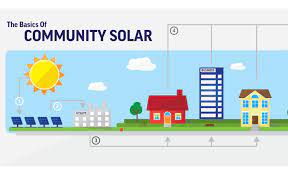Solar rooftop potential for the entire country is the number of rooftops that would be suitable for solar power, depending on size, shading, direction, and location. Rooftop potential is not equivalent to the economic or market potential for rooftop solar—it doesn’t consider availability or cost. Rather, it is the upper limit of solar deployment on rooftops across the country.
Solar rooftop potential for an individual rooftop is the amount of solar that could be installed on that rooftop, based on its size, shading, tilt, location, and construction. Satellite maps, irradiance data, equipment specifications, and other factors inform the bids that installers present to customers to assist them in understanding the potential costs and benefits of solar panels on their roof.
National Rooftop Potential
According to National Renewable Energy Laboratory (NREL) analysis in 2016, there are over 8 billion square meters of rooftops on which solar panels could be installed in the United States, representing over 1 terawatt of potential solar capacity. With improvements in solar conversion efficiency, the rooftop potential in the country could be even greater. Residential and other small rooftops represent about 65% of the national rooftop potential, and 42% of residential rooftops are households with low-to-moderate income.
NREL estimates that an average of 3.3 million homes per year will be built or will require roof replacement—representing a potential of roughly 30 gigawatts (GW) of solar capacity per year. If even a small fraction of these new roofs had solar installations, it could have a significant impact on U.S. solar power generation.
Individual Rooftop Potential
For individual rooftops, national laboratories and private companies have developed a number of tools to estimate the amount of solar that could be installed on a given rooftop. The tools described below were funded in part by the U.S. Department of Energy’s Solar Energy Technologies Office (SETO) to help consumers start the process of choosing solar by determining the solar potential of their homes or businesses.
ENERGYSAGE
EnergySage, a previous Incubator awardee, allows homeowners, businesses, or nonprofit organizations to estimate their energy savings from solar, and connects them with prescreened installers who can provide estimates specific to the user’s address. Users can comparison shop and select the system that fits their needs best. Electricity bills are used to estimate the potential savings from solar energy, and Energy Sage has been found to offer customers substantial savings over more conventional products.
PVWATTS
PVWatts is an online tool from the National Renewable Energy Laboratory (NREL) that estimates the energy production and cost of electricity for grid-connected photovoltaic (PV) solar power systems throughout the world. It allows homeowners, business owners, and nonprofit organizations to easily develop estimates of the performance of potential PV installations, based on online map or user supplied data. Another online tool from NREL is the System Advisor Model (SAM), a free software that enables detailed performance and financial analysis for renewable power systems.
SUN NUMBER
A previous Incubator awardee, Sun Number gives a numerical score which represents the solar suitability of a building’s rooftop on a scale from 1 to 100, with 100 being the ideal rooftop for solar. Scores can be accessed by entering a valid address in a region where the analysis has been performed. The Sun Number score is created from aerial imagery that is processed with proprietary algorithms to accurately analyze individual rooftops, and based on a combination of factors, each weighted uniquely to provide an accurate analysis of a rooftop. Factors include roof shape, surrounding buildings, surrounding vegetation, regional variability, and atmospheric conditions. The company also partnered with Zillow, an online home-listing service provider, which culminated in the addition of a solar potential listing to the descriptions of over 40 million homes.
Business Tools
AURORA SOLAR
Aurora Solar Inc., a previous Incubator awardee, developed a web-based application that quickly calculates the solar potential of a building’s rooftop. The application uses image recognition and computer vision algorithms to assess and compare many potential sites.
DGEN: DISTRIBUTED GENERATION MARKET DEMAND
This tool simulates customer adoption of distributed energy resources for residential, commercial, and industrial entities in the United States or other countries through 2050. It is able to analyze the key factors that will affect future market demand for distributed energy resource. In the future, dGen will be an open source tool.
FOLSOM LABS
Folsom Labs, a previous Incubator awardee, developed a solar permit generator—a software engine to automatically generate standard documents for inspectors and authorities having jurisdiction (AHJs). AHJs require these documents to authorize solar arrays in their jurisdiction. The software uses Helioscope, a design and engineering product offered by Folsom Labs, to quickly create the permit documents, single-line diagrams, site plans, and design details.
NATIONAL SOLAR RADIATION DATABASE
This tool provides a serially complete collection of hourly and half-hourly values of meteorological data and the three most common measurements of solar radiation: global horizontal, direct normal and diffuse horizontal irradiance.
PVLIB
PVLib is an open-source software package that allows users to simulate the performance of photovoltaic energy systems. There are two different versions (pvlib-python and PVILB for Matlab) that have grown significantly from contributions from an active community of users.
REEDS: REGIONAL ENERGY DEPLOYMENT SYSTEM
ReEDS simulates electricity sector investment decisions based on system constraints and demands for energy and ancillary services. Its high-spatial resolution and advanced algorithms are able to represent the cost, value, and technical characteristics of integrating renewable energy technologies.
REOPT LITE: RENEWABLE ENERGY INTEGRATION AND OPTIMIZATION
REopt Lite recommends the optimal mix of renewable energy, conventional generation, and energy storage technologies to meet cost savings, resilience, and energy performance goals.
REV: THE RENEWABLE ENERGY POTENTIAL MODEL
reV is a first-of-its-kind, spatio-temporal modeling assessment tool that empowers users to calculate renewable energy capacity, generation, and cost based on geospatial intersection with grid infrastructure and land-use characteristics.
SYSTEM ADVISORY MODEL
Also known as SAM, this free, techno-economic software model enables technical performance simulation and financial analysis of renewable energy projects. SAM combines time series weather data and system specs to calculate potential electricity production and uses system cost, compensation, financing, and incentive data in an annual cash flow to calculate levelized cost of energy, net present value, payback period, internal rate of return, and revenue of a potential project.
Continue reading

Subscribe to our newsletter
Promotions, new products and sales. Directly to your inbox.


